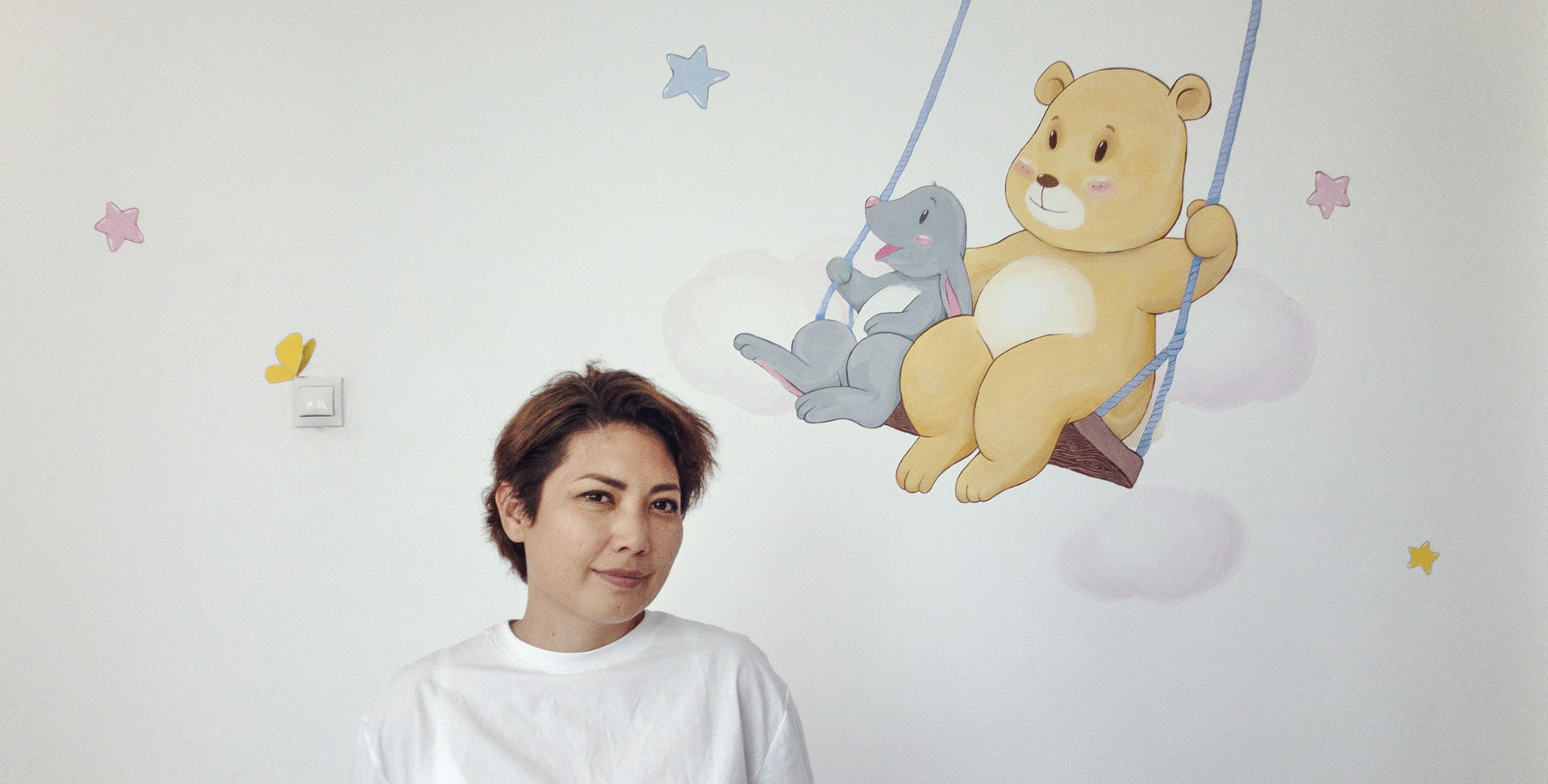Dinara Aliayeva founded the first (and so far the only) children’s hospice in Kyrgyzstan. For several years her team has been providing support at the system level to children diagnosed with cancer and other severe or terminal illnesses. They also organize delivery of clothes, food, medications and vital equipment to the children in need and their families.

CHILDREN
My name is Dinara Aliayeva. I am a founder and president of The First Children’s Hospice charitable foundation.
For five years now I have been working at the Helping Is Easy («Помогать легко») foundation that supports children’s unit of the National Cancer Center (NCC) in Bishkek. While working at the foundation I learned a lot about the problems that existed in the unit. After a year of working at the foundation I started to think of opening a hospice.
At that time the chief of children’s unit was fired from NCC for numerous violations. Multiple layers of malpractice were uncovered, including lack of anaesthesia, violations of patients’ and parents’ basic right for information and their right to choose doctors, concealing the number of deaths in the children’s unit… Many parents could not get death certificates as they would be officially denied any supporting documents.
The new team of the children’s unit started with a clean slate and we closely cooperated with them. We initiated the exchange of best practices with foreign experts. Because the new team of doctors was determined to work openly and to do their best for the benefit of the children, we were able to assess the patients’ needs. And, of course, the very first issue was helping those children who could not be cured.
Numerous stupid stereotypes are present in our society — like “you shouldn’t give morphine to patients as they might become addicts”
It is terrible when kids are diagnosed with diseases for which there is no treatment yet or when the disease just would not give up… Unfortunately, when children are diagnosed with terminal illnesses, at best they are sent back home. In these cases parents are just left alone with their troubles, paralyzed with fear and grief. They find themselves in a situation when their child suffers from pain but has no access to painkillers. Sometimes they get talked out of giving their kid painkillers because of the numerous stupid stereotypes that are present in our society — like “you shouldn’t give morphine to patients as they might become addicts” or “you cannot do chemo because after that the person will never recover”…
When children are born with congenital diseases, doctors and medical staff often convince the parents that they should have an abortion or abandon their babies, thus deciding the fate of the unborn child or tearing it away from loving parents. In the West, this issue has long been resolved very simply — parents are explained that even if their child does not live long, they can still surround him with love and care which they prepared to give him, and they get assistance in taking care of the baby. Unfortunately, in our country it happens in a completely different way — a huge number of children are kept in neuropsychiatric orphanages. These kids stay in orphanages for months and years and do not get any affection or care from their families. I think that even if no one talks about this problem, it doesn’t make it any less of a pain for so many people.
All I had were the deep understanding of the problem and the desire to convince others to help the hopelessly ill children
Until the hospice was opened, neither I nor my co-workers had had any idea of how hospices functioned. We just truly believed that a hospice for children who were suffering and dying was really needed. All I had were the deep understanding of the problem and the desire to convince others to help the hopelessly ill children. I asked the city administration to allocate premises for the hospice, but for some reason premises just would not be found… I started to talk about the issue to my friends and people I knew, and they would, in turn, pass the information to their friends — until we found the patron who decided to help us.
HOSPICE
Our hospice’s first address was in Bishkek suburbs where we rented a house for it. Bit by bit, we equipped it. Friends, friends of friends, companies — everyone would help us somehow. But as the first year passed, our patron told us his business wasn’t going well so he could not continue supporting us anymore.
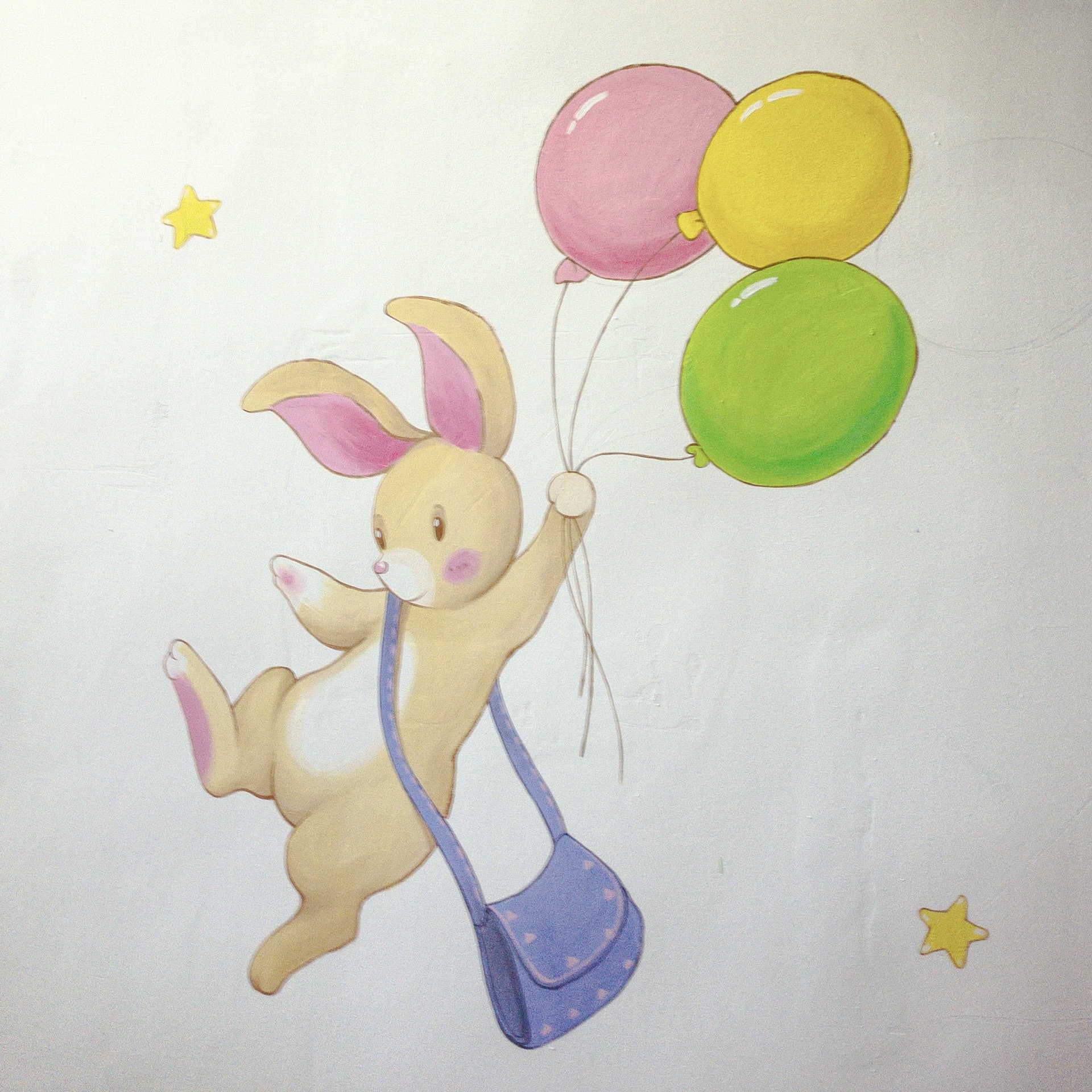
Photograph by Dmitry Markov / @dcim.ru
It was a terrible news. We found ourselves in a situation when there were ill children in the hospice, and we all — the children and the team — could end up on the streets…
So we started writing about our situation on social media. By that time a lot of people knew about the children’s hospice. Public reaction was huge, so the city mayor found a building for the hospice within a month, as well as the resources for its renovation. For over a year now we’ve been working in the building that the city hall allocated to the hospice. It’s nice and cozy. The hospice is exempt from rent and utility payments. And we’re really grateful for the support.
There were over 500 illnesses children could be diagnosed with that implied hospice palliative care
We stated from scratch. We did not have experts, neither did we have trained nurses. What we started with was studying the issue and researching the subject through specific literature. We then realized that our view of the problem had been too narrow. Initially we considered only children with cancer, but apparently the scale of the problem was much, much bigger. According to WHO (The World Health Organization — Å), there were over 500 illnesses children could be diagnosed with that implied hospice palliative care. But for us and the society these kids were seemingly not there, they were invisible. So we wanted to find them…
WORK
We had to go to considerable lengths, we would go to family practices and children’s hospitals and tell them about the hospice we had opened and that we could help terminally ill children who lived with their families. We would go to addresses in the lists we’d been given.
We started the off-site hospice visiting service and placed all the kids we could take to the hospice. Thanks to donations, we bought a minibus that is used for hospice needs. We deliver humanitarian aid, medical staff members go to see the kids, our therapist visits the families, talks to the kids and their parents.

We’ve seen a lot. There was one family from our list, we came to their home and saw the child who had been in a coma for many years. But her parents were taking such a good care of her that she looked as if she was taking a short nap. There was also a completely different situation when we visited a family where there were no ill children, but they were getting disability allowance for kids.
Currently there are 9 employees in our hospice team. We accept children not only from Bishkek and its suburbs, but from other regions of the country as well. We also have an office in the neuropsychiatric orphanage in Belovodskoye village. We attracted 8000 US dollars in financial support to this orphanage. It is the largest neuropsychiatric orphanage in the country; currently there are over 120 children, 80 of them are bedridden for life because of congenital diseases. These kids are also under our hospice’s care.
We are planning to open a palliative care office in Osh and to start working with the maternity hospital in Karakol. We want to have an opportunity to hire more people. For several years we have gained valuable experience. Our team members are carriers of the unique expertise that we must share with doctors, medical staff and social workers in the regions. But, unfortunately, due to limited financial resources, we cannot do it on at the proper level now.
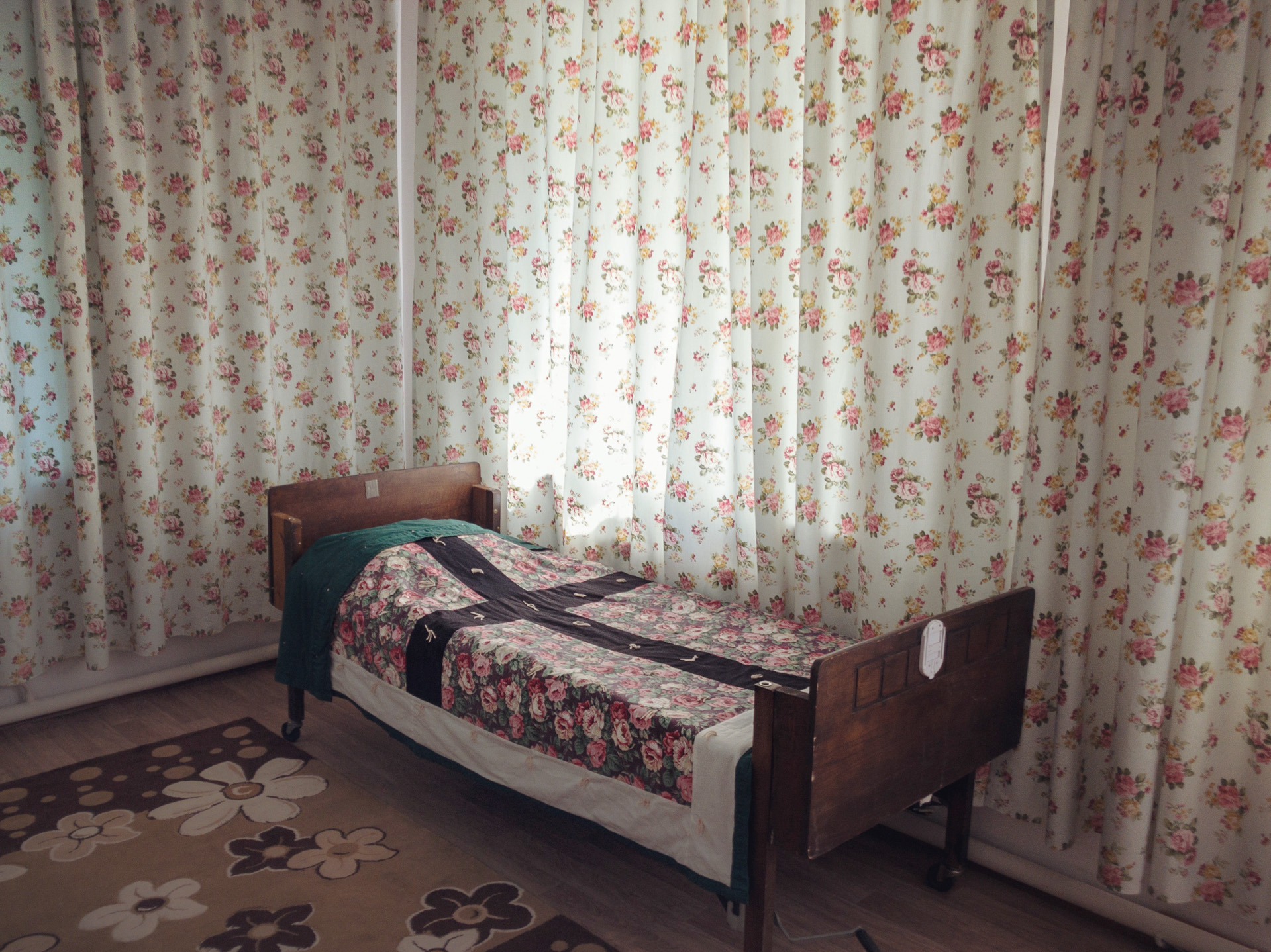
We try really hard and work a lot… But on a national scale, what we are doing now is so little! When you realize how many children still cannot get adequate support, it is just frustrating. Many kids have little access or no access at all to pain relieving medications.
Unfortunately, the government does not allocate either funding or attention to the issue of palliative and hospice care. Hence, our patient category is left unsupported. Therefore now we need a stable backing from the government in terms of sustainable work in the field of palliative care throughout the country. Together with the government, we need to come up with the long-term action plan. And state funding has to be directed toward such important goals.
For instance, in Belarus they built an advanced ultramodern hospice, which looks like some spaceship. The state makes annual budgetary provisions for the Belarusian children’s hospice. And it’s not some small funding we’re talking about, but around a million US dollars per year. The situation is similar in Georgia, where significant public funding is allocated to the children’s hospice.
We can only assume what the real numbers are, but there are at least ten thousand children who need a palliative hospice care
Unfortunately, in our country there is still no serious nationwide research made, so we don’t know for sure how many children need a palliative hospice care. Thus, we can only assume what the real numbers are, but there are ten thousand children at least…
TEAM
The most important issue in our work that remains unresolved is the the staff salaries and the hospice maintenance expenses. When we bring a child from the intensive care to our hospice, he can be in a coma for a long period of time. Here our staff members wash him, feed him and take care of him, the therapist works with his parents. Not everyone understands the agony that a child with stage IV cancer goes through, when he’s conscious but is in extreme pain… And far not everyone understands what a tremendous job it is to take care of these children — in psychological, emotional and physical sense. It is a very hard job that not any medical worker can withstand — because of the heavy stress associated with it.
Our staff members work for an average salary that nurses, therapists and physicians get in our country — from 7 to 15 thousand soms (100 to 220 USD — Å) per month. Working at the hospice is not just about the serious stress levels but also the risk to health and life.
Some people quit because it is too heavy a burden… One of our nurses had a stroke and died after the kid she had been taking care of and who she’d become so emotionally attached to, passed away…
That’s why I am so grateful to those who appreciate the importance of the job that the hospice workers do. Many people do not realize that people doing this job have to be paid — it is beyond their understanding of charity. But it’s of no less importance than raising money for an urgent surgery for a child, or vital medicines, or shelter for a family that was made homeless…
I am really grateful to people and organizations that try to solve — each on their own level — the problems that palliative patients face. Some of them raise money, some raise awareness and others work on the advocacy.
At the beginning stage of our work we invited the founder of Almaty hospice for children, Nagima Plokhikh, to Bishkek. She gave a lot of useful information and guided us at that early period of our hospice. We truly appreciate her help. We also work very closely with the Russian foundation — Children’s Palliative («Детский паллиатив») and with our colleagues in Belarus. We receive all the methodological literature on children’s palliative care from them and consult them on most of the issues. Besides, we always invite foreign experts who can share expertise and tutor medical workers in our country.
Our hospice relies on small private donations from people and organizations. From the very start Kumtor Operating Company’s staff have been helping us a lot. Each employee donates 50-100 soms (1-2 USD) every month, so together they cover a monthly salary for the hospice nurse. Many thanks to them! Ayu Garant insurance company has been covering our therapist’s salary for a year. Universal Logistics company has been doing the same for our driver. Starting from the last year, Eurasian Development Bank has been sending donations to us. The bank employees donate money, and the head office doubles the amount. They did that twice already. Certainly, this support means a lot to us.
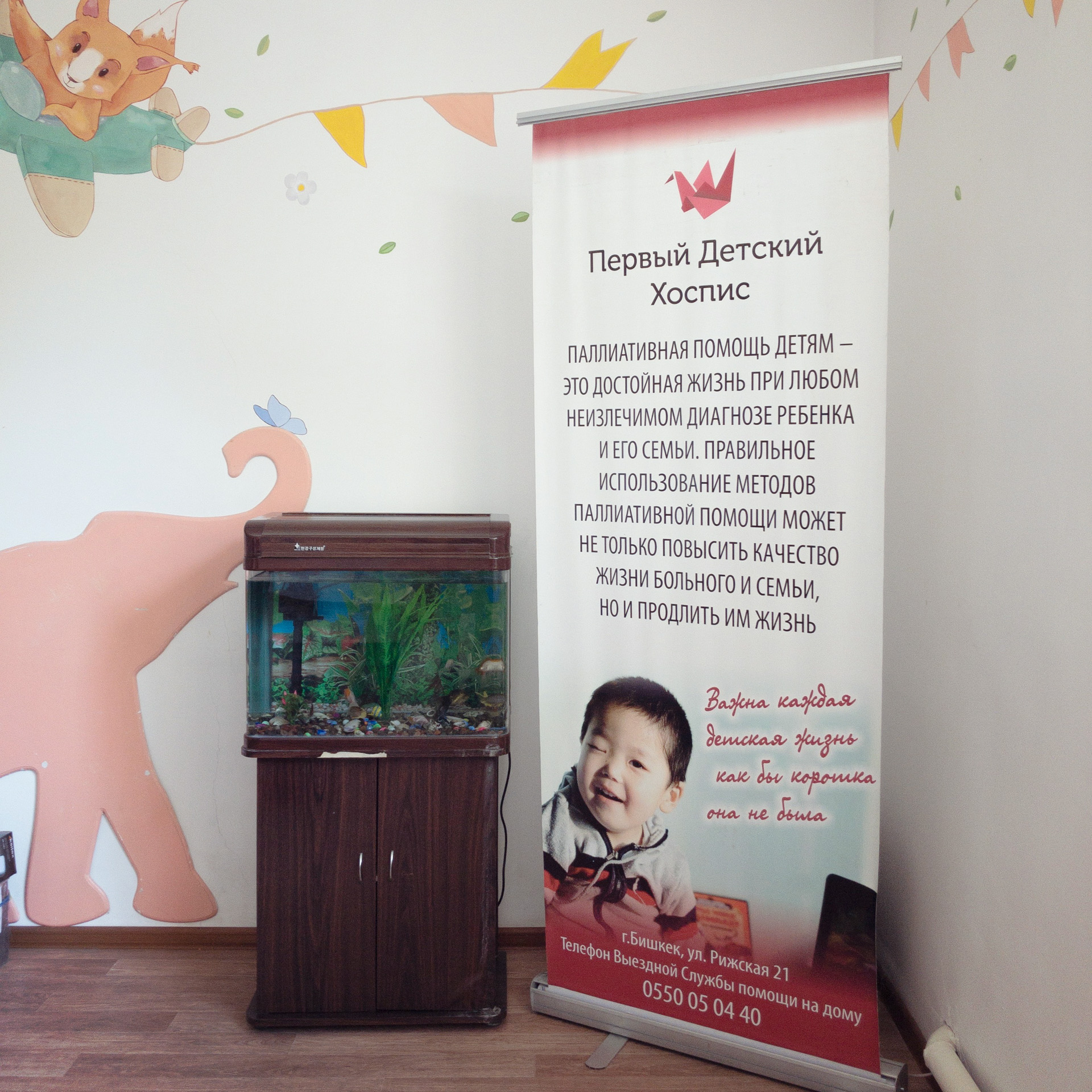
Currently there are more than a hundred children under our care. Around 30 of them live with their families. From 70 to 80 kids are registered with our office in the neuropsychiatric orphanage in Belovodskoye — for them we organize monthly visits by a team of doctors who keep their symptoms under control and prescribe necessary medications. We also keep receiving children diagnosed with cancer and children from intensive care. It is often the case that our kids need urgent surgeries or expensive medications, because most of them are diagnosed with rare, severe or terminal illnesses.
LOVE
Currently we only have 10 rooms. Each can accommodate children with their relatives.
When a child is at the end of life, his whole family can stay with him: parents, sisters, brothers. This year we started the work towards open intensive care units, because we get a lot of requests from parents who cannot get an access to their children under intensive care. It is a huge problem when a little kid who is faced with a serious disease gets separated from his close ones. Therefore, we hope that we’ll be heard and parents will be able to stay with their children at intensive care units.
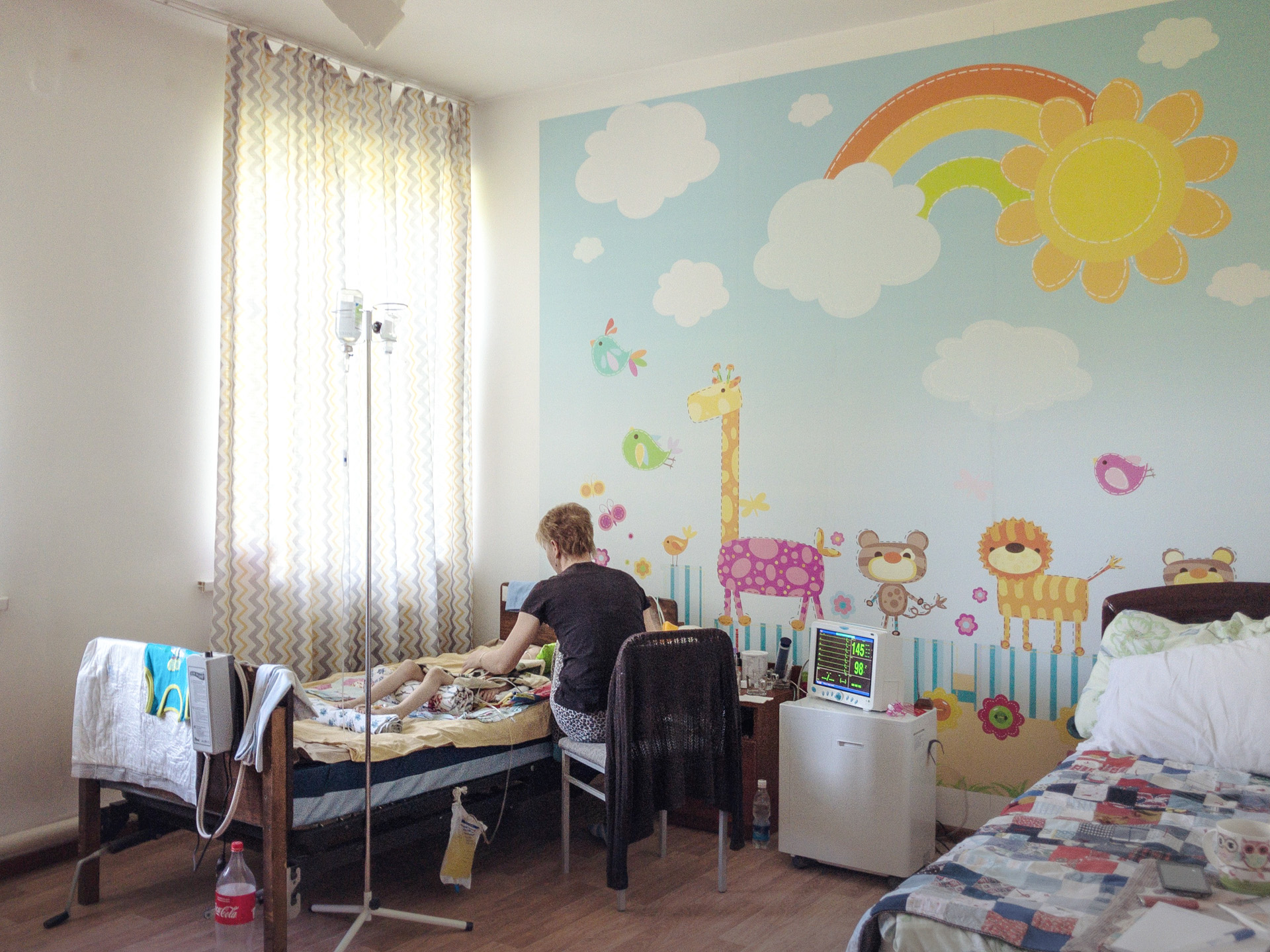
We are also planning to offer perinatal palliative support for parents who wish to keep their babies despite life-limiting diagnoses, welcome them to the world and take care of them.
No matter how long a person is destined to live, he should live this life surrounded by love and care. Especially if it is a child. Especially if it is a child who will never grow up…
You asked me if there had been cases of recovery in the hospice… Yes, fortunately, we had one. It was a boy, he had no parents and lived under his grandmother’s custody. He fell from the second floor and got seriously injured; after a surgery he fell into a coma. When they brought him to our hospice, his arms and legs were cramped, the whole body was twisted. He lay in a coma for a month and a half. But thanks to the efforts of our nurses, thanks to the care and work of the whole team, we pulled him out of a coma and put him back on his feet.
Oh, that was just a miracle for us! A kid who got to the hospice completely unconscious, after a severe injury, eventually recovered and went out of the hospice on his feet. Unfortunately, his grandmother could not keep taking care of him after that trauma, so he ended up in an orphanage… But we keep in touch with him and always visit him, because this kid has become a part of us, our dear one.
ADAMDAR/CA team would like to express gratitude to film director Elnura Osmonalieva (Bishkek, Kyrgyzstan), documentary maker Dmitry Markov (Pskov, Russia) and the team of Kyrgyzstan’s First children’s hospice for the help in preparing this article.
You can support the First children’s hospice in Kyrgyzstan by donating money directly to the hospice’s account. All the money will be used to support the patients and maintain the work of Kyrgyzstan’s First children’s hospice team.
Bank account information:
ОБФ «Первый детский хоспис»
Account in KGS: 1280096037288596
БИК 128009 ЗАО "КИКБ" ОКПО 29400186
ИНН 01502201610205
You can get more information about the ways to donate to the hospice from their official page and by phone: +996 559 647 457
